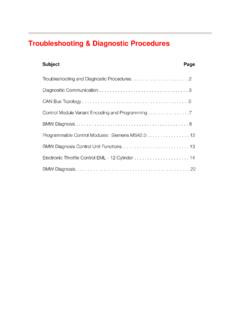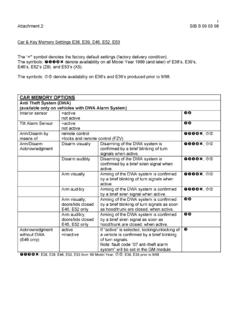Transcription of Table of Contents Starting Systems - e38.org BMW …
1 Initial Print Date: 5/01 Revision Date:SubjectPagePurpose of Starting of of ContentsStarting Systems2 Starting SystemStarting SystemsModel: AllProduction Date: AllObjectivesAfter completing this module you should be able to: Explain the purpose of the Starting system . List and identify the components of the Starting system . Recognize the different types of starters. Diagnosis Starting system SystemStarting SystemsPurpose of the Starting SystemThe purpose of the Starting system is to convert chemical energy stored in the battery intoelectrical energy, then into mechanical energy in the starter motor. This mechanical energyis then transferred through gears and drives from the starter motor to the engine the transfer and conversion of all this energy the engine flywheel begins to rotation must be of sufficient speed to allow the engine to form the combustible air-fuelmixture required for Starting .
2 It must be maintained during initial combustion long enoughuntil the the engine can sustain operation. To accomplish this a starter or cranking motor is Starting system consists of the following compo-nents: Battery Ignition Switch Starter Motor Assembly EWS (if equipped) Starter Safety Switch Cables and Wiring HarnessSystem ComponentsBatteryThe Battery is the primary EMF source in the automobile. The automotive battery is an elec-tro-mechanical device that provides the potential difference (voltage). The battery does notstore electrical energy. It stores chemical energy that is converted to electrical energy as energy for Starting the car is drawn from the battery.
3 State-of-charge, and capacity ofthe battery are important factors in the ability of the engine to start, especially in cold andharsh Starter2. Battery3. Ignition4. SystemIgnition SwitchThe Ignition Switch provides a request to the Starting system to engage the starter request is handled differently depending on the year of the vehicle and particular sys-tems the vehicle is fitted non EWS Systems the ignition switch provided power directly to the starter solenoid or astarter relay. Beginning with EWS I the start request (KL50) is passed to an Immobilizercontrol module or an EWS module (EWS II/III).On vehicles with one touch Starting the KL50 signal is passed to the Motor AssemblyThe Starter Motor Assembly is a DC motor which uses the interaction of magnetic fields toconvert electrical energy into mechanical starter motor assembly consists of: Electric Starter Motor Solenoid Pinion Engaging DriveElectric Starter MotorThe Starter Motor provides the mechanicalenergy to rotate the engine through a direct or a gear reduction major components of the starter motor are.
4 Armature Shaft (1) Armature Winding (2) Armature Stack (3) Commutator (4) Poles Shoes (5) Field Coil (6) Carbon Brushes (7) Brush Holder (8)3121. Electric Starter Motor2. Solenoid Switch3. Pinion Engaging SystemArmatureThe Armature assembly is comprised of the armature shaft, armature winding, armaturestack and commutator. Thin iron stampings are laminated together to form the stack orcore. The slots on the outside of the laminations hold the armature windings. The windingsloop around the core and are connected to the commutator. Each commutator segment isinsulated from the adjacent segments. The commutator may have up to 30 segments.
5 Asteel shaft is insert in the center hole of the laminations with the commutator insulated fromthe CoilsThere are two types of field coils: Electromagnetic Permanent magnetElectromagneticWire ribbons or coils wrapped around a pole shoe, attached to the inside of the starterhousing. The iron pole shoes and the iron starter housing work together to increase andconcentrate the strength of the field coils. When current flows thought the field coils strongelectromagnetic fields with North and South poles are permanent magnets manufactured from an alloy of boron, neodymium and iron arepositioned in the starter housing. Use of permanent magnets allow for the elimination ofthe field circuit and windings and realize a 50% weight SystemBrushesBrushes are electrically conductive sliding contacts, usually made of copper and brushes make contact with the commutator and as the starter begins to rotate thebrushes reverse the flow of current to the armature.
6 Starter brushes carry the full flow ofcurrent through the Solenoid assembly is an integral part of thestarter and is actually a combined relay andengagement solenoid. The solenoid has two functions: Pushing the pinion forward so that it engagesin the ring gear of the engine. Closing the moving contact, providing the main current path for the solenoid has two windings. Pull-in winding Holding-in windingBoth windings are used to draw in the plunger and engage the pinon, only the hold-in wind-ing is used to hold the plunger in Engaging DriveThe starter s end shield assembly contains the Pinion Engaging Drive with pinion, overrun-ning clutch, engagement lever and spring.
7 The drive mechanism is responsible for coordi-nating the thrust motion of the solenoid switch and the rotary motion of the electric startermotor and transferring them to the starter engages the ring gear on the flywheel by means of the pinion. A high conver-sion ratio of pinion teeth to flywheel teeth (between 10:1 and 15:1) make it possible to over-come the high cranking resistance of the engine using a relatively small but high speedstarter soon as the engine starts and accelerates past cranking speed, the pinion must auto-matically demesh in order to protect the starter. For this reason, the starter incorporates an overrunning switch and pinion engaging drive7 Starting SystemsStarter DrivesConventional DriveIn a Conventional Drive starter the pinion gear is locat-ed directly on the armature pinion and overrunning clutch form the driver assembly rides on a helical spline on thearmature shaft so that when the driver is thrust by thesolenoid, a combined axial and rotary motion occurswhich greatly facilitates the meshing of the Drive End Shield2.
8 Engaging Lever3. Meshing Spring4. Driver5. Roller Type Overrunning Clutch6. Pinion7. Armature ShaftGear Reduction DriveIn their design and function, Gear Reduction Drives are much the same as conventionaldrive starters. The main difference in the gear reduction drive starter is a planetary gear setadded between the field frame and the drive end shield. This design allows for the use ofsmaller and lighter Planetary-Gear Carrier Shaft with Internal Gear (Ring Gear).3. Planet Gears4. Sun Gear on Armature Shaft5. Armature6. Commutator7510113 SystemOverrunning ClutchIn all starter designs the rotary motion is transmitted via an Overrunning Clutch.
9 The over-running clutch allows the pinion to be driven by the armature shaft (or planetary gear set),however it breaks the connection between the pinion and the armature shaft as soon asthe accelerating engine spins the pinion faster than the overrunning clutch is located between the starter motor and the pinion and preventsthe starter motor armature from being accelerated to an excessive speed when the Clutch Cover2. Pinion3. Driver with Clutch Shell4. Roller R-ace5. Roller6. Pinion Shaft7. Coil Springa Direction of Rotation for Clutch Locking Actiona5476321 Fully assembled permanent magnet gear reduction starter1. Drive End Pinion3.
10 Solenoid Switch4. Terminal5. Commutator EndShield6. Brush Plate W/Carbon Brushes7. Commutator8. Armature9. PermanentMagnet10. Field Frame11. PlanetaryGear12. Engaging Lever13. Pinion SystemEWSThe EWS system (s) is designed to provide electronic anti-theft protection for the vehiclethrough the use of coded keys and coded data communication between the EWS and theengine control module. The starter and engine control module are locked out until a prop-erly coded key is recognized and the proper code is established between the EWS and theengine control Safety SwitchThe Starter Safety Switch is part of the transmission range switch on automatic transmis-sion vehicles and a clutch switch on manual transmission vehicles (beginning MY 1997).











